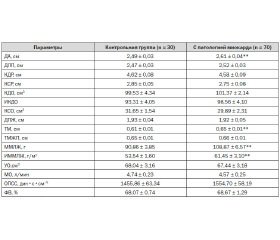Журнал «Здоровье ребенка» 4 (64) 2015
Вернуться к номеру
Particular neurohumoral relations with diastolic dysfunction in adolescents with myocardial pathology
Авторы: Bogmat LF, Nikonovа VV, Tolmachevа SR, Vvedenskaya TS. - SI "Institute for Protection of Child and Adolescent Health NAMS of Ukraine", Kharkov
Рубрики: Педиатрия/Неонатология
Разделы: Справочник специалиста
Версия для печати
It was found that more than 40% of patients with clinical signs of heart failure systolic function of the left ventricle myocardium preserved undisturbed or slightly reduced, but the recorded signs of myocardial relaxation disorders of varying severity. It is proved that the mechanisms of formation and progression of CHF special role neurohumoral systems - the sympathetic-adrenal (SAS) and the renin-angiotensin-aldosterone (RAAS). In this regard, it is important to study the characteristics of neurohumoral provide adolescents with abnormal myocardium in different types of diastolic dysfunction of the left ventricle of the heart.
We observed 70 adolescents aged 13-18 with abnormal myocardium (37 of them - with arrhythmias, 18 - with dysplastic cardiomyopathy, 15 - with hypertension). Morphological and functional cardiac parameters were studied using ultrasound in the "M" and "B" mode using the sensor 3.5 m Hz on the machine "Sonoline-SL1" according to standard procedure. LV diastolic function was studied in the pulsed Doppler transmitral flow with the mapping from the apical four-chamber heart of access. To identify the type of diastolic dysfunction (DD) was carried out tests with isometric exercise (ID). Studied the plasma renin activity (PRA), angiotensin-II (A-II) and aldosterone (Ald), and the daily urinary catecholamine excretion. Statistical processing was performed using the software package Statgrafics Centurion on ІBM PC / Pentіum-4.
Analysis of morphological and functional cardiac parameters in comparison with the control group, found a significant increase in the diameter of the aortic root (r<0,05), thickening of the left ventricular posterior wall (r<0,01), as well as a significant increase in LV myocardial mass (r<0.01) and LV myocardial mass index (r<0,01). Systolic function did not differ from controls.
In the study of the parameters of left ventricular diastolic function revealed some features. Thus, the temporal parameters (IVRT and DT) did not differ from the control group at the same time the peak E, which characterizes the rate of the first phase of the passive LV filling was significantly lower in the group of adolescents with abnormal myocardial (r<0,01), as well as and the peak A (r<0,01), which characterizes the rate of the active, atrial phase LV filling. The ratio E/A was a tendency to increase (r<0,1). This data indicates the formation of diastolic LV function in the studied adolescents.
To clarify the type of diastolic dysfunction of the LV myocardium of the heart to all adolescents core group performed test with ID. According to the results of this trial were divided into 3 subgroups according to the index the ratio E/A. In one sub-group includes persons whose E / A was < 1,5 cu in 2 - teenagers who have E/A is in the range 1.5 - 2 and 3 - in which E / A was> 2.
Adolescents 1 subgroup, compared with the control group, found a significant decrease in wave E (p<0.01), an increase of wave A (p<0.01), respectively, and a decrease of E / A (p<0.01), indicating that a violation of the first phase of LV relaxation. The trend towards an increase in DT also confirms the formation in this subgroup of type I DD (type slow relaxation). In the subgroup of 2 found a downward trend in peak E (r<0,1), the parameters of peak A virtually unchanged, which contributed to a significant decrease in the E/A (p<0.01). Attention is drawn to a significant decrease in DT (p<0.05) and a decrease in IVRT (p<0.01). The changes revealed evidence of the formation of these teens signs of type II DD. 3 In the subgroup reported a significant decrease in peak E (p<0.01) and A (p<0.01), increased E / A (p<0.01). Furthermore, it is noted slowing DT, and tends to decrease IVRT (p<0.1). The results indicate the formation of the most marked disorders DF mokarda by reducing the waves E and A waves, and their correlation with the increase of more than 2.0 cuIn the study of urinary catecholamine levels in adolescents with PM, taking into account the nature of the changes in diastolic function, the greatest activity of this system has been established in patients with early signs of diastolic dysfunction. At subsequent stages of diastolic disorders was a slight increase in the excretion of norepinephrine, but there is a significant activation of the RAAS at the expense of all its components, but particularly significant increases aldosterone levels.
Regression analysis allowed to identify the components that yavlyayutsya the most important in the formation of certain types of LV diastolic dysfunction.For example, in one subgroup of adolescents ratio E/A is associated with indicators of adrenaline (Kd=19.5%) and norepinephrine (Kd=30.1%), the share of which is quite high. Adolescents with type II DD formation changes function is significantly influenced by aldosterone (75.5%) and only partially - noradrenaline (Kd=15.5%). In the formation of type III diastolic dysfunction is set multicomponent influence neurohormonal systems, but with a significant predominance of the RAAS. Thus, studies have revealed the most significant neurohumoral factors of formation and progression of diastolic dysfunction of the left ventricle of the heart. The highest value in the processes of progression of diastolic dysfunction belongs RAAS components and most of all - aldosterone.

